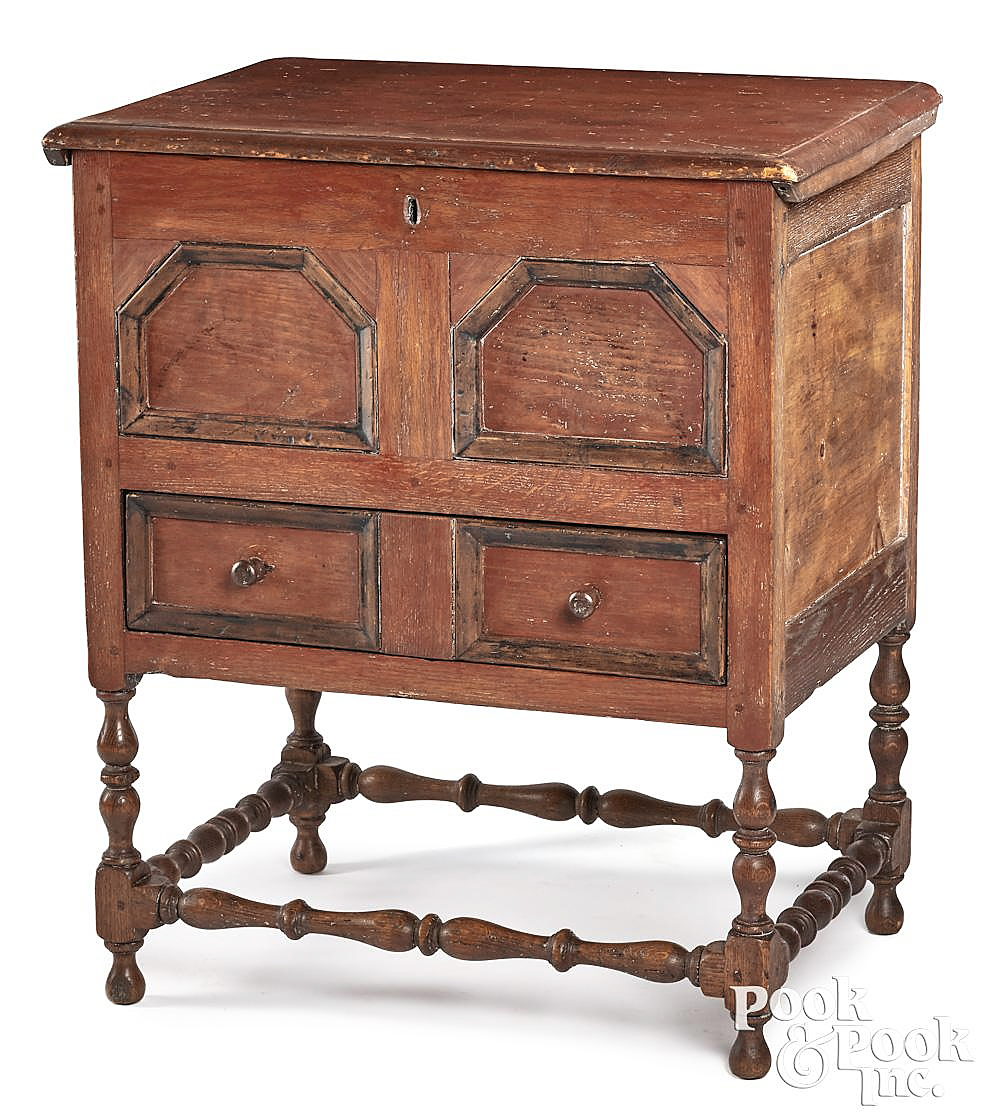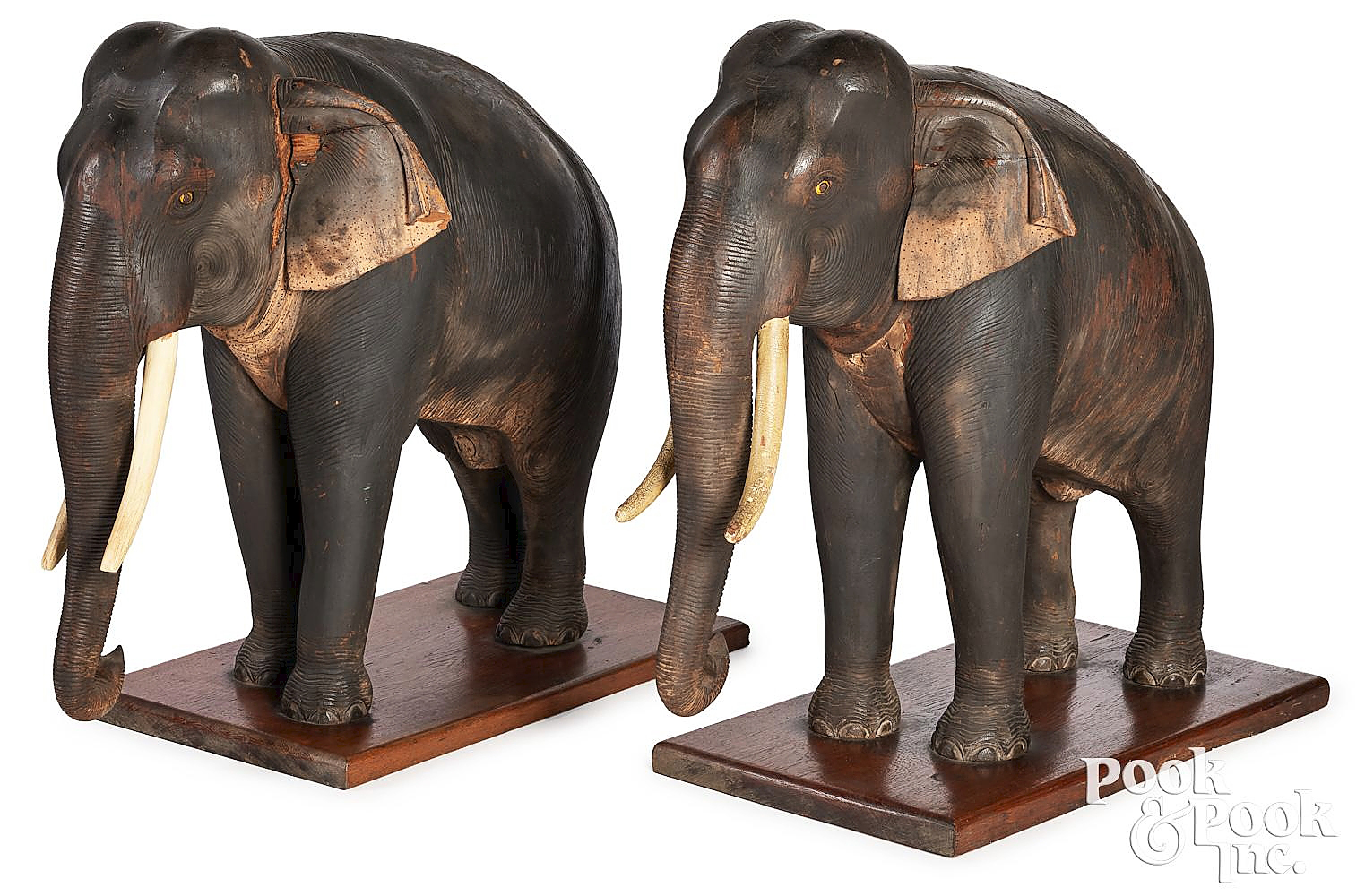
The highest figure achieved in all three days’ sales was $362,500 for this beach scene by Sir John Lavery from the Strassburger Estate, far exceeding its estimate of $60/90,000.
Review by Z.G. Burnett, Images Courtesy Pook & Pook
DOWNINGTOWN, PENN. — It was a lively three days at Pook & Pook from January 18 to 20, which saw the collection of Margaret Berwind Schiffer come to auction, followed by two sessions of Americana & International objects. “The sale was very successful, all three days,” said founder Ron Pook. “Almost surprisingly successful! It was a fairly decent crowd, locals and even some bidders who flew in from Europe.” The in-house pool was about 50 to 60 attendants for the Schiffer sale, and 40 to 50 for the two-day auction. Remote bidding was especially active on PookLive! and Bidsquare. Although there were a few dealers, the bidders were mostly collectors. From 1,024 lots offered, 98 percent sold overall. The high estimate of all three sales amounted to $2,686,800 and the final total was $4,009,957.
Margaret Berwind Schiffer (1923-2022) was a noted collector of Americana, needlework and Christmas toys, among many more categories. An authority on the material culture of early Chester County, Penn., Schiffer authored numerous books and articles on historical needlework and lectured at the Metropolitan Museum of Art, the Museum of Fine Arts, Boston, and other prominent institutions. She began collecting to furnish her 1730 home in West Chester, Penn., and according to Pook, rarely sold anything in the past 50 years. “That really helped the sale,” he commented. “She had incredible needlework, weathervanes, furniture, everything.”
Most coveted by bidders was an important Pennsylvania Queen Anne walnut armchair, circa 1750, that topped the Schiffer sale at $88,200. Pook & Pook once had its eye on the chair, too. “We knew she had it,” said Pook. “We’ve been trying to get it for years.” The chair showed a shell carved crest, solid splat and outward scrolled hands with knuckles above, as well as shell carved cabriole legs with slipper feet supporting a compass seat, a very rare form. Pook also noted the “magic” surface that had seemingly never been refinished, “If it was, the chair would have sold for less than half [of what it did].” There were only eight bids volleyed for the chair, and it went to a private collector.
Case furniture was prominent in the auction’s top lots, and all were early American pieces. First was a William and Mary (circa 1725) cedar spice chest on small bun feet and showed incised potted tulips on its overall surface, which is unusual for Pennsylvania chests this early. The catalog suggests that the decoration is an early precursor to the to “line and berry” furniture of Chester County from Philadelphia, which is indicated by the use of cedar as a primary wood. The chest sold for $75,600. Another diminutive winner was a miniature Queen Anne (circa 1760) walnut chest with raised panel sides and likely original brass drop pulls. In overall good condition, it achieved $57,960, almost five times its high estimate. Probably from Philadelphia, the largest case piece in the top lots was a William and Mary (circa 1730) chest of drawers with inlaid tulip and berry designs on walnut and concentric circle inlays with quarter circle corners on the top surface. The chest sold for $30,240.

This circa 1800 pewter flagon originally from St Michael’s Lutheran Church in Philadelphia and from the Donald and Patricia Herr pewter collection sold for
$35,000 to Michael and Suzanne Payne, whose estate will give it to the Lutheran
Archives ($8/12,000).
The first listed and the second highest selling lot of the Schiffer sale was an important silk on gauze needlework sampler. Dated 1807, it was made by Elizabeth Finney at Mrs Leah Meguier’s School of Harrisburg, Penn., and was cited as “one of the best works” from the well-documented group. The scene remains in an excellent state of preservation and was derived from an early engraving of “Spring” from James Thomson’s poetry series, The Seasons (1726-30). The sampler is distinct from others of its type due to the coiled brass and silk border, which elevated the price to $75,600.
Two Charles II (circa 1670) stumpwork lots did well, both more than tripling their estimates. First was a mirror, the embroidered scenes and looking glass of which were enclosed in a mahogany and tortoiseshell veneer frame, that achieved $42,840. The second stumpwork piece was a rare, embroidered casket with allegorical royalist scenes, as well as the actual monarchs and court, decorated with animals, insects and flowers. The chest retained its original ebonized pinewood case, and closed at $32,760.
Fine art led the second day of the Americana & International auction, particularly lots from the Strassburger Estate of Normandy Farms, Penn., that included the highest figure or all three days with “The Beach Deauville – Morning” by Sir John Lavery (British, 1856-1941) for $362,500 to a bidder in the room. Another successful lot from this collection was an oil on canvas rendition of Gilbert Stuart’s “George Washington at Dorchester Heights,” attributed to his daughter, Jane Stuart (American, 1812-1888). Stuart was a prolific artist of her own work and also created copies of her father’s paintings; this example sold for $21,420. Andrew Wyeth (1917-2009) represented another dynasty of American artists with the watercolor titled “The Lookout” or “Borestone Mountain.” Bought by Rosalie Downing from the Christmas Shop of Hotel DuPont around 1950, the painting descended in her family and was also bought in the room for $55,000.
Pennsylvania furniture maintained its popularity in the Americana & International sales. The top lot of the first day was an 1843 pine hanging cupboard, painted with a schoolhouse, American flag and nature surrounding. Within the grass and trees are people and animals, mostly geese and dogs, under a starlit sky. From a prominent Manhattan collection with provenance to David Schorsch and Eileen Smiles and Christie’s, the cupboard more than quadrupled its high estimate to $50,000. From the Fetherston Trust and the Packwood House Museum came a Nineteenth Century two-part corner cupboard with an original flame and tiger grained surface that achieved $32,500. An earlier pine schrank from around 1770 followed in price, its painted surface elaborately decorated with birds, vases and flowers, for $18,900. The second day’s sale produced another William and Mary (circa 1720) case chest on a frame in pine, but this example had Connecticut origins. Showing a paneled body with the baluster legs and stretchers of its era, the chest bid to $18,750.

Crafted circa 1700, bidding for this painted pine schrank grew to $18,900 ($7/10,000).
The second highest lot in the first day’s sale also came from Fetherston and Packwood, the Pennsylvania journal of gunsmith Samuel Baum with entries dated between 1789 and 1826. The journal contains about 38 calligraphic illustrations, including a gun stock, multiplication tables and astrological charts, among other subjects. One of the biggest surprises of all three days, the journal was estimated at $400/600 and soared to $45,000.
Philadelphia pewter from the collection of Donald and Patricia Herr bid to success in the first day’s sale, including a flagon attributed to the “Love” maker that sold for $35,000 to Michael and Suzanne Payne. The flagon has provenance to St Michael’s Lutheran Church, Philadelphia, and the Paynes will make it a promised gift to the Lutheran Archives from their estate. Another 1763 flagon from the collection, attributed to Johann Philip Alberti, bid to $17,640. Just below this at $17,500 was a rare Eighteenth Century teapot with the Love touchmark, with provenance to Henry J. Kauffman and included in his 1970 book The American Pewterer: His Techniques & His Products. The Herrs’ pewter will be included in only one more sale, coming to Pook & Pook in the fall.
Lisa Minardi, dealer and director at Historic Trappe, revealed to us that she had “some important purchases [at the sale], including the inlaid walnut kitchen dresser, the parrot inlaid spice box, two of the Quaker delft plates, a line and berry chest of drawers, and the low chest with overhanging top.
Prices quoted with buyer’s premium as reported by the auction house. For information, 610-263-4040 or www.pookandpook.com.


























